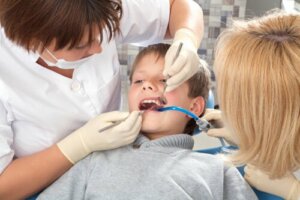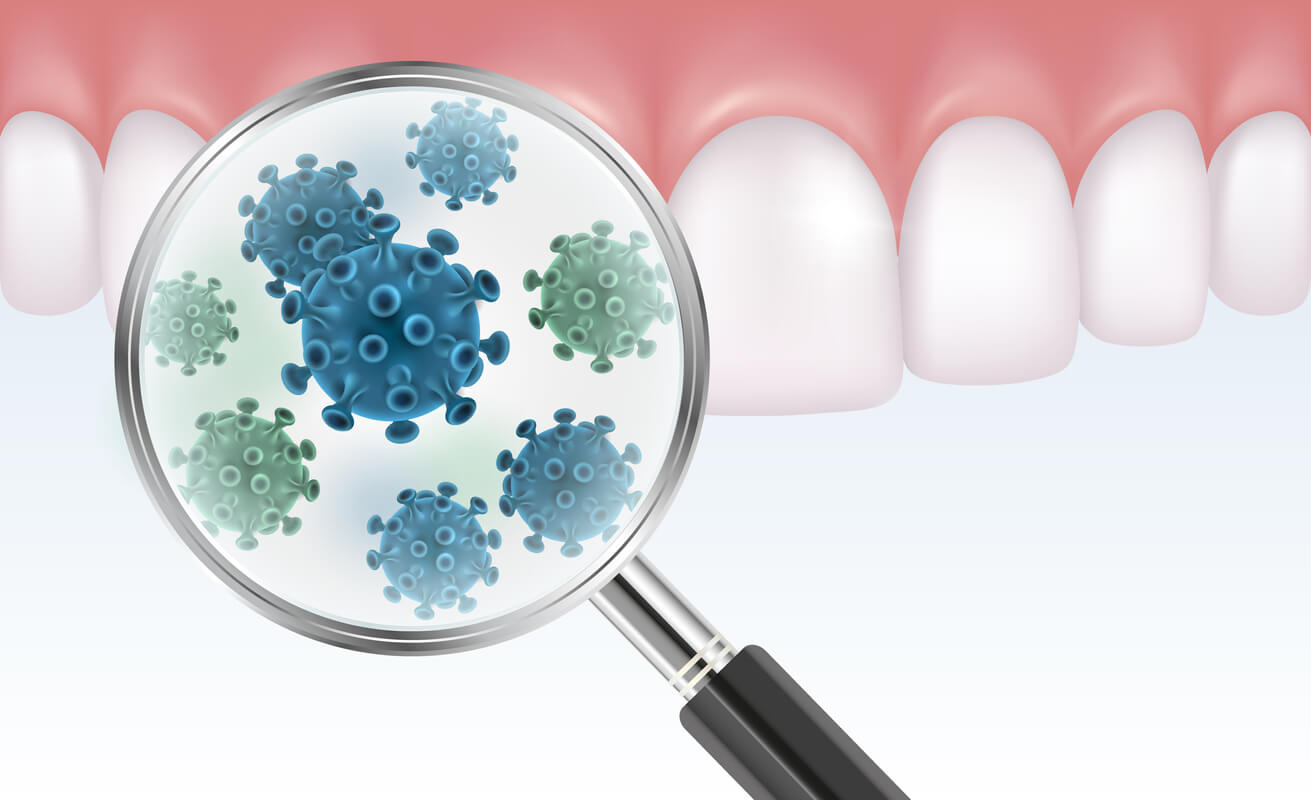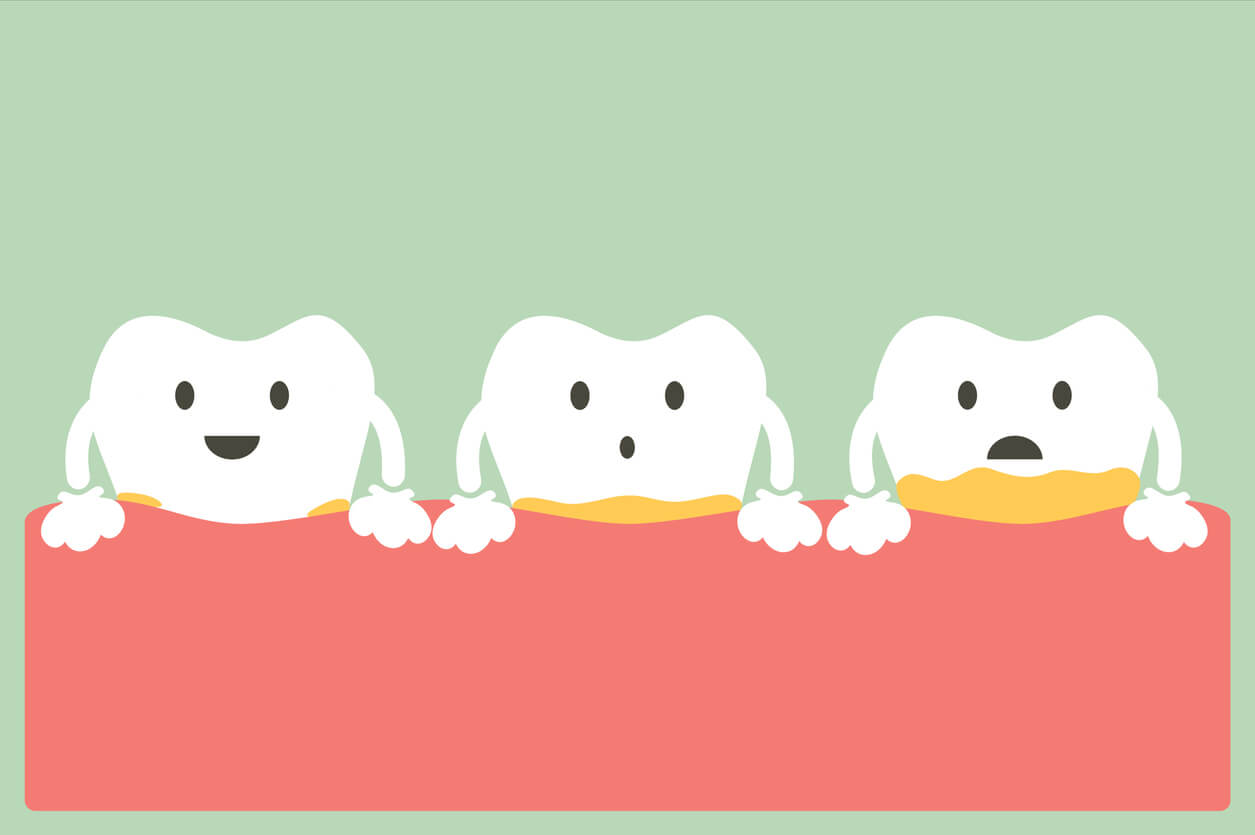Bacterial Plaque and Tartar in Children


Written and verified by the dentist Vanesa Evangelina Buffa
Many adults aren’t aware of the relationship between bacterial plaque and tartar that forms in children. Others consider them to be the same thing and some even think that they’re problems that only affect the elderly. In this article, we’ll tell you what bacterial plaque is, how it’s formed, and what the risks are. We’ll also clarify its relationship with the formation of tartar in children and its health consequences.
What is bacterial plaque?
To understand what bacterial plaque is, we need to know that there are different microorganisms in the mouth that make up the oral microbiome. Bacteria are found in saliva but can be deposited on oral structures. At the same time, the proteins present in saliva form an invisible, cell-free layer on the teeth, called an acquired film. Different species of bacteria are deposited on this film to form bacterial plaque.
Bacteria bind to each other through a complex mechanism that uses proteins in saliva and sugars from the diet. Carbohydrates from food are also used by the microorganisms to grow and multiply. From the union and proliferation of bacteria, bacterial plaque arises. It’s a soft and sticky film that accumulates on tooth surfaces and gums.
Problems arise when this film isn’t removed regularly or when a diet rich in sugars is consumed, which provides the germs with the nutrients they need to multiply and accumulate more and more.

The consequences of bacterial plaque in children’s mouths
Bacteria present in bacterial plaque metabolize sugars in the diet and produce acids capable of destroying the hard tissues of the teeth. If this process is prolonged over time due to inadequate hygiene, cavities appear. In addition, their presence on the gums causes gingivitis. This condition is more severe if the plaque hardens and turns into tartar.
If these processes progress, they can cause more serious and uncomfortable damage to children. For example, stains and breaks in the teeth, loss of teeth before their time, and pain and infections that alter the quality of life of children.
How bacterial plaque looks in children
As soon as it’s formed, bacterial plaque is colorless and can go unnoticed by the naked eye. However, if it’s not removed regularly by brushing, its appearance will begin to change and become more noticeable. Therefore, as it thickens, it can be seen as a thick white deposit, with the appearance of accumulated food debris. It’s especially visible in the area where the tooth and the gum come together.
In addition, if the child passes their tongue over their teeth, they’ll perceive a rough sensation. If the dentist passes an explorer over the tooth surface, the film comes out with the scraping and is observed on the instrument. There are also other indicators that can alert parents to the presence of accumulated plaque:
- Bad breath
- Red and swollen gums
- Bleeding gums when brushing teeth
- Yellowish or stained teeth
- Dental sensitivity
What is tartar?
Tartar is also known as dental calculus or tartar. It’s a substance that’s produced by the hardening and calcification of bacterial plaque when it’s not eliminated. Tartar in the mouth is much more evident than bacterial plaque. It’s visualized as a hard, yellowish-white, or brownish formation, deposited on the tooth surfaces. Its presence then affects the aesthetics of the smile of children.
Its texture is rough, which favors the accumulation of more bacteria. Calculus can be located on any tooth, although it’s more frequently observed on the internal faces of the lower incisors. In addition, although it’s not as common in childhood, if the condition progresses, it can cause more severe periodontal problems.
At the same time, tartar is much more difficult to remove than bacterial plaque. In this case, brushing and flossing aren’t enough and a dentist will have to remove it with specific instruments. Therefore, its elimination is done through dental cleaning or prophylaxis. This procedure removes tartar deposits and cleans the surfaces of the teeth, leaving them smooth and shiny.

Why do bacterial plaque and tartar accumulate on children’s teeth?
Most of the time, the presence of bacterial plaque and tartar in children’s mouths is due to inefficient or non-existent oral hygiene. In addition, there are other situations that favor their formation:
- Poor oral hygiene: Incorrect or infrequent tooth brushing predisposes children to bacterial plaque and tartar. Not using dental floss also causes its accumulation in the area between the teeth.
- Dry mouth: The lack of saliva prevents this fluid from fulfilling its function of cleaning the mouth. In a dry oral cavity, it’s easier for bacteria to accumulate and tartar to form. In children, dry mouth is related to mouth breathing and to the use of some medications such as those used to treat asthma and allergies.
- Excessive consumption of sugary, ultra-processed, or starchy foods and beverages: The availability of simple sugars provides an easy substrate for bacteria to multiply and proliferate.
Bacterial plaque and tartar in children can be prevented
Controlling the formation of bacterial plaque on children’s teeth and preventing it from turning into tartar is essential to maintain the oral health of children. With daily and simple practices, it’s possible for children to have a healthy mouth and not suffer the consequences that bacteria cause in the mouth.
Parents should be in charge of brushing their children’s teeth at least twice a day. When little ones are able to brush on their own, which happens around 6 and 8 years of age, adults will have to supervise the task and control that the technique is correct. In addition, cleaning should be complemented with the use of dental floss and, if the dentist considers it necessary, with mouthwash.
It’s also important to take care of the diet of your little ones. Healthy foods should be preferred and ultra-processed foods and those with a high content of refined sugars should be avoided. Finally, visits to the pediatric dentist every 6 months are essential.
Many adults aren’t aware of the relationship between bacterial plaque and tartar that forms in children. Others consider them to be the same thing and some even think that they’re problems that only affect the elderly. In this article, we’ll tell you what bacterial plaque is, how it’s formed, and what the risks are. We’ll also clarify its relationship with the formation of tartar in children and its health consequences.
What is bacterial plaque?
To understand what bacterial plaque is, we need to know that there are different microorganisms in the mouth that make up the oral microbiome. Bacteria are found in saliva but can be deposited on oral structures. At the same time, the proteins present in saliva form an invisible, cell-free layer on the teeth, called an acquired film. Different species of bacteria are deposited on this film to form bacterial plaque.
Bacteria bind to each other through a complex mechanism that uses proteins in saliva and sugars from the diet. Carbohydrates from food are also used by the microorganisms to grow and multiply. From the union and proliferation of bacteria, bacterial plaque arises. It’s a soft and sticky film that accumulates on tooth surfaces and gums.
Problems arise when this film isn’t removed regularly or when a diet rich in sugars is consumed, which provides the germs with the nutrients they need to multiply and accumulate more and more.

The consequences of bacterial plaque in children’s mouths
Bacteria present in bacterial plaque metabolize sugars in the diet and produce acids capable of destroying the hard tissues of the teeth. If this process is prolonged over time due to inadequate hygiene, cavities appear. In addition, their presence on the gums causes gingivitis. This condition is more severe if the plaque hardens and turns into tartar.
If these processes progress, they can cause more serious and uncomfortable damage to children. For example, stains and breaks in the teeth, loss of teeth before their time, and pain and infections that alter the quality of life of children.
How bacterial plaque looks in children
As soon as it’s formed, bacterial plaque is colorless and can go unnoticed by the naked eye. However, if it’s not removed regularly by brushing, its appearance will begin to change and become more noticeable. Therefore, as it thickens, it can be seen as a thick white deposit, with the appearance of accumulated food debris. It’s especially visible in the area where the tooth and the gum come together.
In addition, if the child passes their tongue over their teeth, they’ll perceive a rough sensation. If the dentist passes an explorer over the tooth surface, the film comes out with the scraping and is observed on the instrument. There are also other indicators that can alert parents to the presence of accumulated plaque:
- Bad breath
- Red and swollen gums
- Bleeding gums when brushing teeth
- Yellowish or stained teeth
- Dental sensitivity
What is tartar?
Tartar is also known as dental calculus or tartar. It’s a substance that’s produced by the hardening and calcification of bacterial plaque when it’s not eliminated. Tartar in the mouth is much more evident than bacterial plaque. It’s visualized as a hard, yellowish-white, or brownish formation, deposited on the tooth surfaces. Its presence then affects the aesthetics of the smile of children.
Its texture is rough, which favors the accumulation of more bacteria. Calculus can be located on any tooth, although it’s more frequently observed on the internal faces of the lower incisors. In addition, although it’s not as common in childhood, if the condition progresses, it can cause more severe periodontal problems.
At the same time, tartar is much more difficult to remove than bacterial plaque. In this case, brushing and flossing aren’t enough and a dentist will have to remove it with specific instruments. Therefore, its elimination is done through dental cleaning or prophylaxis. This procedure removes tartar deposits and cleans the surfaces of the teeth, leaving them smooth and shiny.

Why do bacterial plaque and tartar accumulate on children’s teeth?
Most of the time, the presence of bacterial plaque and tartar in children’s mouths is due to inefficient or non-existent oral hygiene. In addition, there are other situations that favor their formation:
- Poor oral hygiene: Incorrect or infrequent tooth brushing predisposes children to bacterial plaque and tartar. Not using dental floss also causes its accumulation in the area between the teeth.
- Dry mouth: The lack of saliva prevents this fluid from fulfilling its function of cleaning the mouth. In a dry oral cavity, it’s easier for bacteria to accumulate and tartar to form. In children, dry mouth is related to mouth breathing and to the use of some medications such as those used to treat asthma and allergies.
- Excessive consumption of sugary, ultra-processed, or starchy foods and beverages: The availability of simple sugars provides an easy substrate for bacteria to multiply and proliferate.
Bacterial plaque and tartar in children can be prevented
Controlling the formation of bacterial plaque on children’s teeth and preventing it from turning into tartar is essential to maintain the oral health of children. With daily and simple practices, it’s possible for children to have a healthy mouth and not suffer the consequences that bacteria cause in the mouth.
Parents should be in charge of brushing their children’s teeth at least twice a day. When little ones are able to brush on their own, which happens around 6 and 8 years of age, adults will have to supervise the task and control that the technique is correct. In addition, cleaning should be complemented with the use of dental floss and, if the dentist considers it necessary, with mouthwash.
It’s also important to take care of the diet of your little ones. Healthy foods should be preferred and ultra-processed foods and those with a high content of refined sugars should be avoided. Finally, visits to the pediatric dentist every 6 months are essential.
All cited sources were thoroughly reviewed by our team to ensure their quality, reliability, currency, and validity. The bibliography of this article was considered reliable and of academic or scientific accuracy.
- Ccanto-Coanqui, A., Mamani-Cori, V., Villalta-Negreiros, Y. S., Chique-Pari, J. J., & Rojas-Ortiz, H. R. (2022). Caries dental no tratada y percepción de condiciones orales sobre calidad de vida en niños: Untreated dental caries and perception of oral conditions on quality of life in children. Peruvian Journal of Health Care and Global Health, 6(2), 75-79.
- Chapoñan, C. P., Julca, A. A. G., & Ramos, M. R. V. (2022). Risk factors associated with gingivitis in children–Literature review. World Health Journal, 3(1), 10-13.
- Contador Cotroneo, R., Morales Chvets, A., Motzfeld Espinosa, R., Van Treek Pérez, P., & Zapata Flores, D. (2022). Alfabetización en higiene oral: manual para el control mecánico del biofilm.
- Discacciati de Lértora, M. S., & Lértora, M. F. (2021). Riesgo de caries, en relación a placa bacteriana, observado en una población de niños que ingresan a la escuela primaria.
- Girardeau, Clémence Shopie, Esther Alía García, and Marta Macarena Paz Cortés. “¿ Qué patologías locales y sistémicas puede presentar un paciente pediátrico con respiración oral?.” Biociencias 15.1 (2020).
- Mejía, A. J. F., & Ibarra, M. C. B. (2021). Enfermedad periodontal, prevalencia y factores de riesgo en niños y adolescentes. Revisión de la literatura. RECIMUNDO, 5(3), 359-367.
- Morón, M. (2021). Los biofilms orales y sus consecuencias en la caries dental y enfermedad periodontal. Ciencia e Innovación en Salud.
- Vargas Vargas, N. E. (2020). Índice de placa bacteriana según Silness y Loe en la clínica de Odontopediatría (Bachelor’s thesis).
This text is provided for informational purposes only and does not replace consultation with a professional. If in doubt, consult your specialist.








